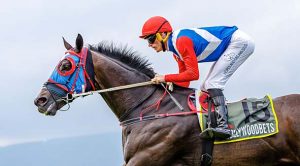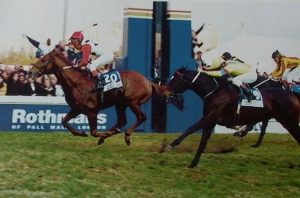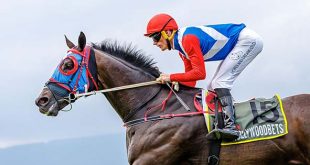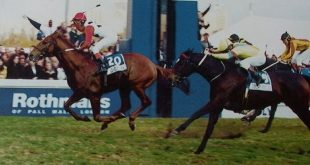Turffontein Standside Saturday 27 December 2025 – Comments by David Thiselton
PUBLISHED: December 26, 2025
RACE 1 11 STAY TUNED 6 CONTINENTAL KING 7 LOOKOUT MOUNTAIN 13 TRAIL RUNNER Preview: 11 STAY TUNED has gone close in both starts and is the one to beat. 6 CONTINENTAL KING has run two fair races and has scope for improvement. 7 LOOKOUT MOUNTAIN is a first-timer by Buffalo Bill Cody out of […]
RACE 1
11 STAY TUNED 6 CONTINENTAL KING 7 LOOKOUT MOUNTAIN 13 TRAIL RUNNER
Preview: 11 STAY TUNED has gone close in both starts and is the one to beat. 6 CONTINENTAL KING has run two fair races and has scope for improvement. 7 LOOKOUT MOUNTAIN is a first-timer by Buffalo Bill Cody out of an Elusive Quality mare and Muzi Yeni is an eyecatching booking. 13 TRAIL RUNNER has been knocking on the door in KZN and should be thereabouts. (11-6-7-13)
RACE 2
1 MASTER’S LADY 2 SAKURA HANAMI 3 POWER OF TIGER 9 VARACHINO’S CHAMP
Preview: 1 MASTER’S LADY failed as last time out but can make amends. 2 SAKURA HANAMI improved last time and should be right there. 3 POWER OF TIGER has the form to earn here. 9 VARACHINO’S CHAMP should finish on top of Master’s Lady on form. (1-2-3-9)
RACE 3
6 ANCHORAGE 3 AFRICAN PRIDE 1 CONSTELLATION 2 CHARMING CHEETAH
Preview: 6 ANCHORAGE won a fine race last time beating a promising speedster. 3 AFRICAN PRIDE can make a bold bid over a step down in trip he will relish. 1 CONSTELLATION won a fine race last time and should be right there. 2 CHARMING CHEETAH has speed and come class and is a contender. (6-3-1-2)
RACE 4
8 MUSICAL SCORE 4 THE EQUATOR 3 FIERY PEGASUS 6 ARGO ALLEY
Preview: 8 MUSICAL SCORE has his peak run and should be cherry ripe over an ideal trip. 4 THE EQUATOR is a relentless galloper and will not be easy to peg back. 3 FIERY PEGASUS is full of class and should make a bold bid over a suitable trip in her second run after a layoff. 6 ARGO ALLEY is in good form and has a chance here over a suitable trip. (8-4-3-6)
RACE 5
9 HAZY DAZY 7 GERBERA 6 SOLDIER’S EYE 1 WILLY MEET AGAIN
Preview: 9 HAZY DAZY looks to be going places and will progress further so can do well carrying just 52,5kg. 7 GERBERA is in good form and should be cherry ripe over this suitable trip. 6 SOLDIER’S EYE is in fine form and should enjoy this trip and she has a plum draw. 1 WILLY MEET AGAIN hasn’t been disgraced in good fields in her last two and should enjoy the step up to this trip. (9-7-6-1)
RACE 6
3 TRUTH 2 PISTOL PETE 1 WILLIAM ROBERTSON 13 KARATE KID
Preview: 3 TRUTH is talented and he is capable of better than last time. 2 PISTOL PETE bounced back to form last time and could follow up. 1 WILLIAM ROBERTSON has a lot of class and is effective over this trip and can carry big weights. 13 KARATE KID is talented and should be running on strongly. (3-2-1-13)
RACE 7
6 RAFA BAY 1 GIMMETHEGOODLIFE 9 AFRICAN PRINCE 2 ESPINOZA
Preview: 6 RAFA BAY has fine form over this trip and should go close again. 1 GIMMETHEGOODLIFE won well in his penultimate start when winning over this trip and might enjoy stepping back down to the minimum trip. 9 AFRICAN PRINCE has some fair Cape Town form so he should show in this centre which is not as strong. 2 ESPINOZA should finish on top of Gimmethegoodlife on form. (6-1-9-2)
RACE 8
4 PLAY WITH THE WIND 1 UMZINGELI WENYATHI 3 MAGIC CARPET RIDE 7 WESTERN WISHES
Preview: 4 PLAY WITH THE WIND won impressively second time out and could be going places. 1 UMZINGELI WENYATHI has some good Cape Town form and should be in the shake up. 3 MAGIC CARPET RIDE won nicely last time and looks to be off a competitive mark. 7 WESTERN WISHES won a nice race last time and can handle a five point raise. (4-1-3-7)
RACE 9
1 NARETOI 2 INCLUSION 3 HEROIC ACT 6 KAVOMOLKA
Preview: 1 NARETOI is knocking on the door and gets a good opportunity here. 2 INCLUSION enjoyed the step up to this trip last time but has a wide draw. 3 HEROIC ACT can earn if repeating his penultimate start. 6 KAVOMOLKA has run well since stepped up to middle distances and has a fair draw. (1-2-3-6)
RACE 10
5 WAR TALK 2 CODEWORD 4 BLOOD OF EDEN 1 FUTURE SUCCESS
Preview: 5 WAR TALK went close when stepped up to 1800m so has a fine chance from pole position over 2000m. 2 CODEWORD will enjoy this trip and should be staying on. 4 BLOOD OF EDEN has a good draw over a step up in trip she might relish on pedigree. 1 FUTURE SUCCESS has shown enough to be able to earn with some improvement which she can still do being by Futura. (5-2-4-1)
Place your trust in Truth
PUBLISHED: December 26, 2025
David Thiselton The Gr 3 Betway Lebelo Sprint heads the ten race Saturday meeting at Turffontein Standside and Truth could give another boost to a family who have been in the news lately. Truth, by Heavenly Blue, is a full brother and stablemate to Trust, who downed Jan Van Goyen in the Gr 2 Jackpot […]
David Thiselton
The Gr 3 Betway Lebelo Sprint heads the ten race Saturday meeting at Turffontein Standside and Truth could give another boost to a family who have been in the news lately.
Truth, by Heavenly Blue, is a full brother and stablemate to Trust, who downed Jan Van Goyen in the Gr 2 Jackpot City Dingaans and the latter followed up by annihilating the best three-year-olds in the Cape in the prestigious Gr 1 Hollywoodbets Cape Guineas. Truth possesses a lot of pace and could emerge as a leading player for the season’s biggest sprint events. He was a touch disappointing in the Gr 3 New Turf Carriers Merchants over 1160m last time out, but he had a big weight in soft conditions and led close to home before fading late. He might appreciate the step down to 1000m and will hopefully get faster going. He faces Merchants winner Pistol Pete on 3kg better terms for a 3,75 length beating, so the latter has his measure on that evidence, but in fact the previous time they met was in the Gr 2 Golden Horse Sprint over 1200m at Hollywoodbets Scottsville and in that race Truth gave Pistol Pete half-a-kilogram and an 8,45 length beating and before that in the Gr 2 TAB Senor Santa Stakes over 1160m the pair had faced each other at level weights and Truth had finished ahead by 0,30 lengths. Pistol Pete was running with blinkers on in those two aforementioned races and they were dispensed with after he was given a nice layoff of three-and-a-half months. His latest run followed a layoff of over two months too. He looks to have benefited from the layoffs and would not be a surprise winner as he has shown a lot of ability at various points in his career. William Robertson is a former Gr 1 Computaform Sprint winner over Saturday’s 1000m course and distance and he still retains ability at seven, although he will have to bounce back from two recent runs that have been a bit below par over 1160m and 1400m respectively. Karate Kid is a hard-knocking sort who will be running on strongly as usual and he also has a winning chance. Whistle The Tune is a talented filly and she has a shout too. She is drawn one, but the Turffontein straight course has been running without the bias it used to have.
The Listed War Of Athena Handicap over 1800m is the other black type feature at the meeting and could see the talented Hazy Dazy earning more black type. She comes off a fine win in the Gr 3 Ducat Africa Fillies Mile. This tall filly is progressive and will enjoy the step up in trip. She copped a seven point raise for that win, but she carries bottom weight of 52,5kg anyway and is only half-a-kilogram under sufferance. On the downside she is drawn widest of all in the 13 horse field. Gerbera has run well twice in her last three starts, proving she is up to her current 94 merit rating. She will relish the step up in trip on pedigree and has Richard Fourie up, but she does have a tricky draw of nine. Soldier’s Eye has a fine chance from a plum draw of two considering she comes off a 5,10 length third in the Betway Summer Cup Consolation over 2000m. Willy Meet Again finished a decent 4,30 length fifth in the Gr 2 Mike de Kock Ipi Tombe Challenge over 1600m last time out and as she is by William Longsword out of a Philanthropist mare who is out of a Candy Stripes mare she should enjoy this trip. The Alyson Wright-trained raider Charge It was beaten just a length by Hazy Dazy at level weights in the Fillies Mile and faces her at level weights again and has a reversal of draw fortunes in her favour, so she could be a big runner even if she is officially 4,5kg under sufferance.
The Non-Black Type Sophomore 1000 could be won by the filly Anchorage, who downed the exciting prospect Manyeleti last time out over this trip and that might turn out to be a good feat in the long run because the latter is ultra quick and possesses a kick. African Pride has also put in some fine performances this season over 1000m. Charming Cheetah was way ahead of a below par African Pride when third in the Merchants last time but before that was beaten 0,70 lengths over this trip by African Pride at level weights in the Listed Golden Loom. Constellation is on the up and can’t be ignored. Kaalvoet wasn’t disgraced in Cape Town and could earn.
In the first leg of the Pick 6, a Pinnacle Stakes race over 1600m Musical Score has his peak run and should be cherry ripe over an ideal trip. The Equator is a relentless galloper and will not be easy to peg back. Fiery Pegasus is full of class and should make a bold bid over a suitable trip in her second run after a layoff. Argo Alley is in good form and has a chance here over a suitable trip. Callmegetrix comes off a 2,80 length third in the Ipi Tombe and is a contender if able to overcome a tricky draw.
In the seventh over 1000m Rafa Bay has fine form over this trip and should go close again. Gimmethegoodlife might enjoy stepping back down to the minimum trip. African Prince brings some fair Cape Town form. Espinoza should finish on top of Gimmethegoodlife on form. Black Egret has the form to contend but might need it.
In the eighth over 1160m Play With The Wind won impressively second time out and wasn’t disgraced last Saturday. Umzingeli Wenyathi has some good Cape Town form and should be in the shake up. Magic Carpet Ride won nicely last time and looks to be off a competitive mark. Western Wishes won a nice race last time and can handle a five point raise. Hathighwaytothesky won third time out and Gavin Lerena is up.
In the ninth over 2000m Naretoi gets a good opportunity here but has a tough draw. Inclusion enjoyed the step up to this trip last time but also has a wide draw. Heroic Act, drawn seven, can earn if repeating his penultimate start.Kavomolka has run well since stepped up to middle distances and has a fair draw of six. Emerald City has run well over 2400m in his last two, having had moderate form before that from 1000m to 1800m, and Richard Fourie is up from a plum draw.
In the first race over 1160m Stay Tuned looks hard to beat presuming the number one draw is not disadvantageous. Continental King is the back up.
In the second race over 1160m Master’s Lady and Sakura Hanami should fight it out.
In the tenth over 2000m War Talk went close when stepped up to 1800m, so will be hard to beat in this field from pole position over 2000m, although Codeword could improve and Blood Of Eden is hard to ignore.

South African Quartet Pools with fractional betting offered at Aintree and Wolverhampton (UK) – 26 December 2025
PUBLISHED: December 26, 2025
Please note: South African Quartet Pools with fractional betting offered at Aintree and Wolverhampton (UK) – 26 December 2025.
Please note: South African Quartet Pools with fractional betting offered at Aintree and Wolverhampton (UK) – 26 December 2025.

Soccer Update and Carryovers: 27 December 2025
PUBLISHED: December 24, 2025
PLEASE NOTE Soccer13 GUARANTEED JACKPOT Saturday 27 December 2025. R36 Million (If only One 13 of 13 Winner). Pool Closes at 16h30. Sport 10 Pool 1. Soccer SCORES Carryover R 102 373. Saturday 27 November 2025. Pool Closes at 17h00 Soccer CORNERS Carryover R 719. Saturday 27 December 2025. Pool Closes at 17h00
PLEASE NOTE
Soccer13 GUARANTEED JACKPOT Saturday 27 December 2025. R36 Million (If only One 13 of 13 Winner). Pool Closes at 16h30. Sport 10 Pool 1.
Soccer SCORES Carryover R 102 373. Saturday 27 November 2025. Pool Closes at 17h00
Soccer CORNERS Carryover R 719. Saturday 27 December 2025. Pool Closes at 17h00
London News July centenary victory
PUBLISHED: December 22, 2025
David Thiselton The 2026 Hollywoodbets Durban July will be a milestone one with the prize money doubled to R10 million and with a longer handicap introduced as the topweight will be upped to 62kg and bottom weight lowered to 52kg. It will fittingly fall on the 30th anniversary of the centenary July, which turned out […]
David Thiselton
The 2026 Hollywoodbets Durban July will be a milestone one with the prize money doubled to R10 million and with a longer handicap introduced as the topweight will be upped to 62kg and bottom weight lowered to 52kg.
It will fittingly fall on the 30th anniversary of the centenary July, which turned out to be one of the greatest of all Julys as it was won by the legendary Alec Laird-trained London News, who went on to put South African racing on the map by winning the QE II Cup in Hong Kong.
The renowned South African wildlife painter Henk Vos released his celebrated work, the Painting Of The Century, depicting a century of July winners, after the July’s centenary running.
The iconic painting now hangs in the Classic Room at Hollywoodbets Greyville.
Alec Laird actually ordered one of the prints of the painting before it was completed as the print had the first of his great Uncle Syd Garrett’s five July winners on the left and the greatest of his father’s record seven July winners, Sea Cottage, was in the centre.
The right hand side just had a blank with a silhouette of a horse, because Vos did not know yet which horse he was going to paint there.
Alec, who trained out of Randjesfontein on the Highveld, related, “He hadn’t made up his mind what horse he was going to put in the last panel (the 20th panel) and he even said to me ‘I would like you to win the July because I would like to put you as the last painting.’ With about a year to go I said to him I’m not going to make it.’”
However, fate then had it that London News not only became the 14/10 favourite for the 100th running of the July, but he was also saddle cloth number 20, being the only three-year-old in the field and the bottom weight.
Piere Strydom recalled, “I remember at the traditional Friday night cocktail Henk Vos was there with his big painting and there was one spot left for the 100th winner and I can still remember saying to someone that I think my picture’s going to be up there.”
London News duly won the race and Alec, London News and Piere Strydom are now at the forefront of the famous painting’s 20th panel and the horse is fittingly carrying the no. 20 saddle cloth.
The London News story starts at the National Yearling Sale of 1994.
Alec recalled big owners Laurie and Jean Jaffee’s chief aim at that Sale was to buy a yearling by their own 1987 July winner, Bush Telegraph.
Alec recalled Harmony Forever being his number one choice at that Sale.
However, he remembered London News being “a nice horse.”
He added, “On the first day a Bush Telegraph colt called Mr Newspaperman went for about R300,000. London News looked more athletic and Jean Jaffee actually said to me, ‘What about this one?’ On the first day they didn’t get a horse, the second day they didn’t get one and the more they asked me about London News the nicer he got, because I was otherwise going to go home without a horse!”
The Jaffees managed to secure London News.
Alec recalled, “He was a light youngster and even as a three-year-old was quite light. He didn’t show immediately, but we always had the feeling that he would be a nice horse when he matured.”
In fact, London News made a particularly inauspicious debut, beaten no fewer than 16,5 lengths under Anton Marcus in a 1200m Maiden Juvenile Plate over 1200m at the Vaal on June 6, 1995.
However, he got better and better and when he smashed the Greyville 2000m course record, which still stands today, in the Gr 1 Daily News 2000, he had won six out of eleven starts including the Dingaans and two middle distance Gr 1s.
Piere Strydom was aboard for the Daily News 2000 too.
He reflected on the 1996 July, the first of his four victories in South Africa’s greatest race, “London News was a lekker horse to ride because he had gate speed, a lot of natural speed and he would travel right up there in front and he had a good kick. But at the top of the straight (having led) I thought with a light weight let me just let the reins go a bit and get a length or two for the short straight. But he accelerated way quicker than I had expected and that’s when he made up three or four lengths on the field. Obviously it was going to tell at the end and he was stopping quite badly at the end. I heard the horses coming and I was just hoping for the line and he held on.”
Alec added, “Mike Rattray had invited me to watch in his box because it was on the line and he won by a neck but my eyes wouldn’t believe it because there was so much pressure. I wanted to see the number up!”
Alec described the emotion of being on the honour roll together with his late record-breaking seven-time July-winning father Syd.
In fact his extended family is comfortably the most prolific July-winning family in history with his grandfather Alec winning one as a jockey, his great Uncle Syd Garrett winning two as a jockey and three as a trainer, his father Syd winning a record seven as a trainer, and the cousins Dennis Drier, Alec Laird and Charles Laird each winning one July apiece – a total of 16 for the July dynasty.









